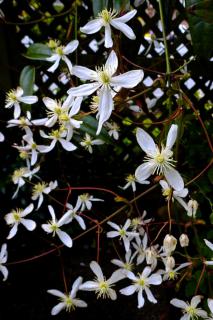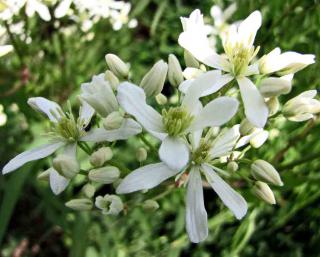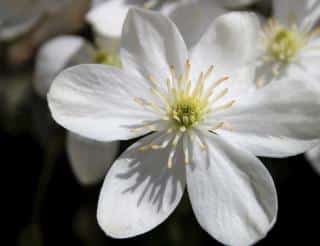

Clematis armandii is a beautiful vine with evergreen leafage and early, fragrant blooming.
Main Clematis armandii facts
Name – Clematis armandii
Family – Ranunculaceae
Type – vine
Height – 6 ½ to 16 feet (2 to 5 meters)
Exposure – full sun, part sun
Soil – deep and cool
Foliage – evergreen – Flowering – spring
They are perfectly suited to old walls, lattices and also container growing.
The most desirable season for planting Clematis armandii is spring, but it can also be done in fall if winter is mild in your area.
The golden rule with Clematis armandii is that the foot of the plant should stay in the shade while the head basks in the sun. If the base is in direct sun, then cover it with for example an old tile or a few odd rocks.
 Place the foot of the plant about 8 to 12 inches (20 to 30 cm) from the lattice or structure you expect it to climb along.
Place the foot of the plant about 8 to 12 inches (20 to 30 cm) from the lattice or structure you expect it to climb along.Clematis is quite easy to propagate.
If you’ve got a terrace, deck or balcony and that you wish to grow your Clematis armandii in a pot, it’s perfectly doable.
For that, selecting the pot and substrate well is important.
Since growing plants in pots is more demanding as regards watering, the solution is to mulch the base of the clematis with a thick layer for it to keep its foot cool while still having its leafage in the sun.
Once properly settled in, Clematis armandii requires very little care.

The more clematis is pruned, the more it bears flowers!
Clematis armandii can take severe pruning in stride. Even if you hard prune it to a stump, it will sprout back new stems.
Watering is a good idea over the 2 first years, but no need to add fertilizer. Doesn’t this make it an easy plant to care for?
Needs of potted plants are more important in pots, because they dry off much faster when the weather is dry.

Clematis armandii is native to China.
Hardiness isn’t what Clematis armandii is best known for. Indeed, it won’t resist temperatures lower than 14°F (-10°C). Consequently, it must be grown with care in places where winters are rather cold.
Areas with milder winters are actually where it will bloom earliest in season, sometimes as early as February. Its flowering will be all the more impressive.
You can attach your clematis to a lattice to ensure it grows the way you hope it will as it develops! Make it strong, because Clematis can live decades and grow rather large!
Hi, we live in Denver Co and drove by a home this evening that has prolific whitish blooms along a fence. The blooms are small, have 4 and 5 petals, stems growing outward; the fragrance is very light. We took a photo with Lens – it was identified as Clematis Armandii. The description is spot on except the zone and the fact that sources report the blooms occur only in spring. It’s the end of September here! Could these be a different variety?
Hi Gigi, identification apps are powerful but sometimes make mistakes. One I find particularly accurate is PlantNet.
Regarding the possible clematis, there are several possibilities:
– it is indeed a Clematis armandii that should bloom in spring, but was whacked out of sync by weather, pruning or other factors
– it is a specific Clematis armandii variety that, unlike its peers, blooms in fall
– it’s another type of Clematis that just looks similar.
This last one is the most probable option, with Clematis terniflora looking very similar to armandii!
Hello;
I have the Armandii variety going on 2 yrs old; was doing very well until just recently. The leaves are all brown, but no insects; mites, fungi etc.
Can I just cut off all the brown leaves & will the plant grow new leaves?
I think its not getting enough sunlight, & is planted next to a row of cedars. Thank you, any help would be greatly appreciated.
Hello Kerrie, I’m supposing you’re in the northern Hemisphere. Clematis armandii normally has evergreen leaves that shouldn’t fall off. But a late frost might have tipped the scales and made it lose its leaves in the past month or two.
There are rare cases of plants just dying off for no apparent reason. After all, they are living organisms and sometimes nature has its quirks. But still, given the context it might be that it just got stressed out.
Lack of sunlight alone won’t explain this since Clematis armandii can also grow in part shade – unless it gets really too little sun. If you know it only gets an hour of direct sun in the day or less, then it’ll be difficult for the plant to survive.
Cutting off brown leaves is a good idea. They should grow back. Check the stem itself by scraping bark off: if it’s green, slick or looks wet, then it’s still alive. But if brittle, dry and brown underneath, then the branch is dead and you can cut that portion off. Do this until you reach a live portion.
I am delighted with my one-year old climates armandii in every respect so far. I would like to grow more of it and would like some advice on how to propagate it. The one I have is planted in flower bed with only acid soil with a gardenia and a camellia sharing the space. Please advise as I know with its flowering season coming to an end perhaps it would b a good time to multiply it. Please advice or if there’s a video that would b a visual lesson for me as I am a novice flower- gardener. Thank you!
Hi Maria, what works best with clematis is layering. It’s a bit long, since from one stem you can only get one or two more a year later, but it works very well.
To layer it, detach a stem from the lattice or treillis without cutting it from the plant. Bend it delicately down to the ground along your flower bed, and dig two or three holes in places where it touches the ground, about 4-5 inches deep (10-15 cm). Bury the stem in the hole, make sure at least one leaf node is underground in each hole. Use a metal hoop or something to lock it in place, and fill the hole back up again. Place a flat rock to keep the soil and stem in place, it will also keep the ground beneath it cool, which clematis likes. In the end it should look like the Loch Ness monster coming up and down out of the ground! Water these places where the stem is buried often.
There is a full article on layering here, and on this video, at 1 min 55 seconds, it shows clearly how to layer a blackberry bush – it’s exactly the same thing on a clematis!
Cuttings also works great, with 6 to 8 inch sections of stems (15 to 20 cm). Not all will make it, so make sure to prepare a half-dozen at least.
Tried to register on your forum this morning, didn’t want to play.
#however I do have a question, I have recently purchased a Armandii Clematis, ‘snowdrift’ the place I want to plant it is against a wall at the moment is in the shade, but then isn’t the whole country. as the sun moves round the sun reach this wall, mid to late afternoon, the root stock will be in the shade. Will this location be ok?
Hello David – and sorry for the forum issue. We worked on the code last Friday and you’ve noticed we’ve still got something to fix! Hopefully within the week the forum will be operational again.
Regarding your Clematis, yes, I think that location would be ideal! Full sun for the leaves, not a problem even if warm afternoon, as long as the base of the stem is cool.
The plant collar can’t breath very well when in full sun (dries the bark out), so if in the sun, laying an object in front of it or growing a low shrub there would be perfect.
I have an old armandii clematis (planted in 2002) that has been mostly allowed to grow wild, but now it has started to pull down the lattice and is invading the eaves of the house, and has a LOT of dead leaves and dead wood all intertwined with the live stuff. How can I prune it back to a manageable size without killing it? The original stemwood is 4-5″ in diameter. It’s in a perfect spot for keeping its feet cool and its leaves sunned upon, so it is quite a monster.
Hello Liz, Clematis armandii is a very vigorous grower. There’s no limit as to how much you should cut off, since it would even grow back from a stump.
Maybe make a quick sketch of your wall and decide how large you want your clematis to be. Sometimes it helps to have a drawn reference, especially when a lot of cutting is involved.
You can cut any branches that are larger than desired. For everything that’s within the designated size, select four to 6 main stems that will remain in place at the end and remove all the rest. Removing the dead wood is a bit difficult, but cutting it in smaller sections with a short, sharp handsaw works well!